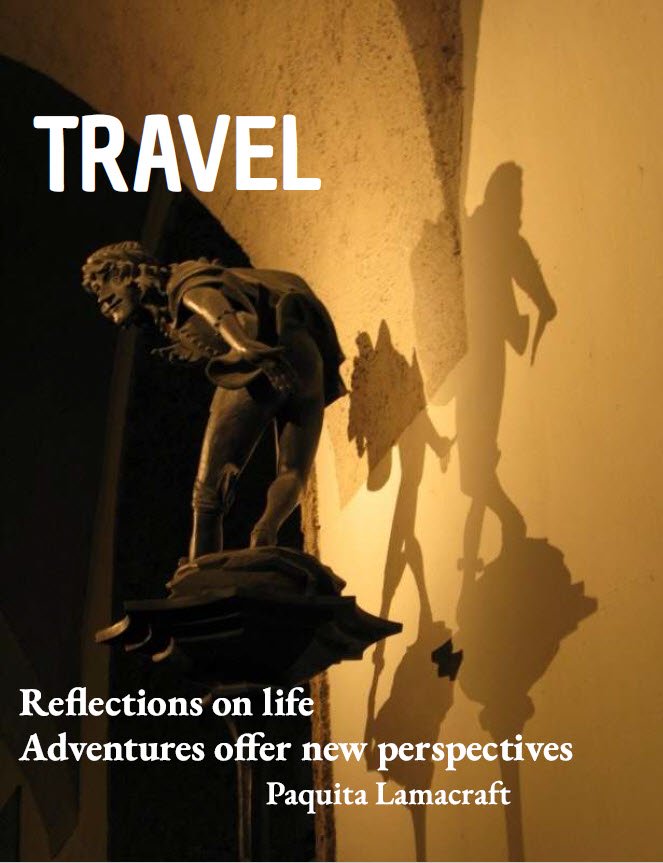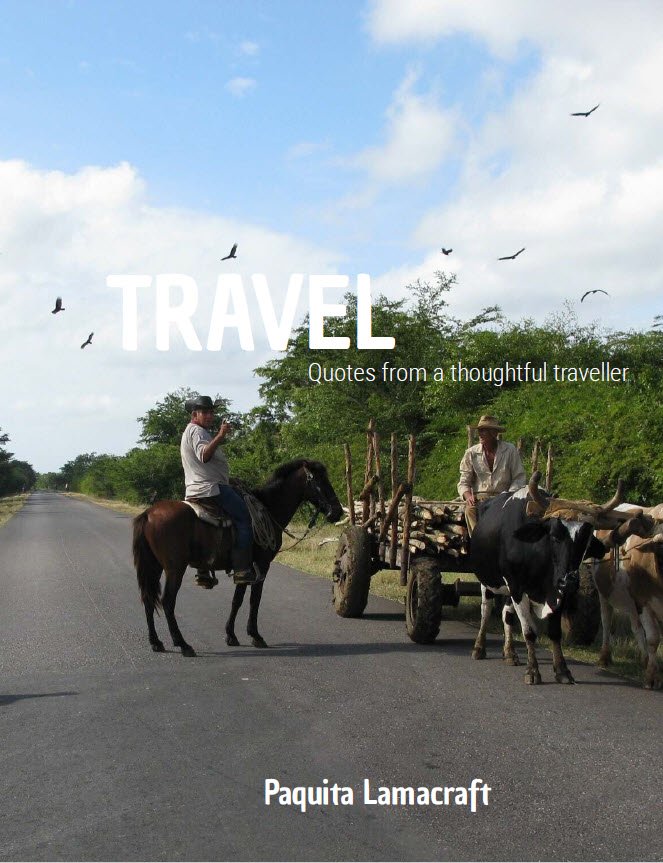Trinidad de Cuba
Entrance to the colourful town of Trinidad de Cuba
Trinidad de Cuba is something of a surprise.
Its entrance, with a small replica of the Manaca-Iznaga tower (which sits 14km outside the town), gives no indication of the character of a place that holds UNESCO World Heritage status.
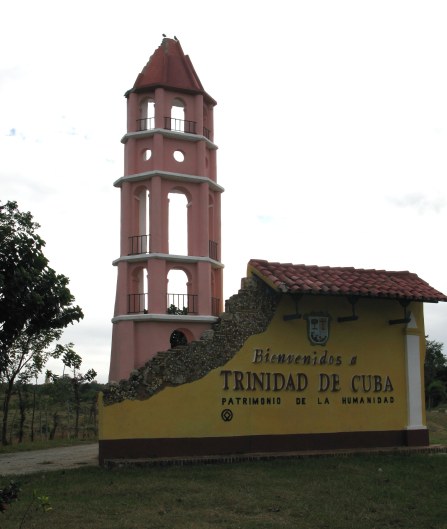
Trinidad's importance to Cuba
This was once one of the most important cities when Cuba was the world’s leading sugar exporter.
This area, now known as the Valley of the Sugar Mills, was the hub of the industry.
Reports vary about how many mills there were (40 to 70) but what does seem commonly agreed is that over 30,000 slaves worked here.
Trinidad de Cuba was founded in 1514 and one of the early settlers was the Basque plantation owner Francisco Iznaga who became mayor of the young city in 1540.
The now famous tower erected on one of his plantations is the most picturesque survivor of an industry that once underpinned the nation’s economy, and is still an important export.
Along Trinidad's cobbled street, to history colourfully painted
The cobbled streets of Trinidad are lined by colourful houses…
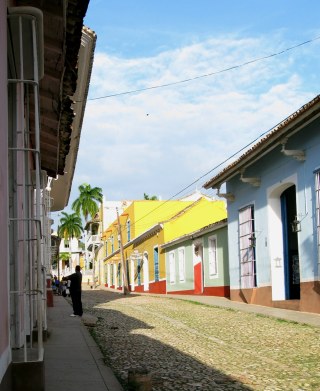
…with decorative grills over the windows…
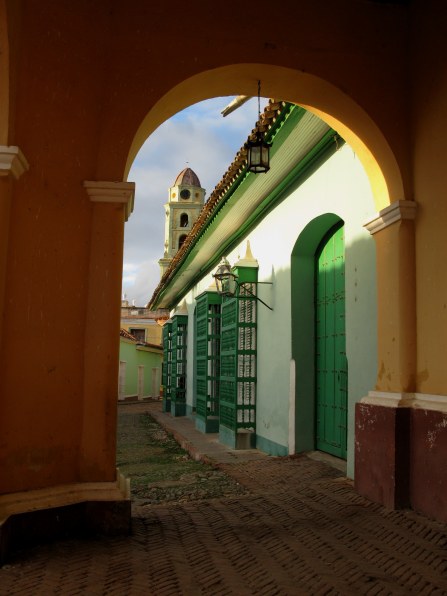
…and above them hang the festoons of jumbled electrical and telephone wires that one comes to expect in Cuba.
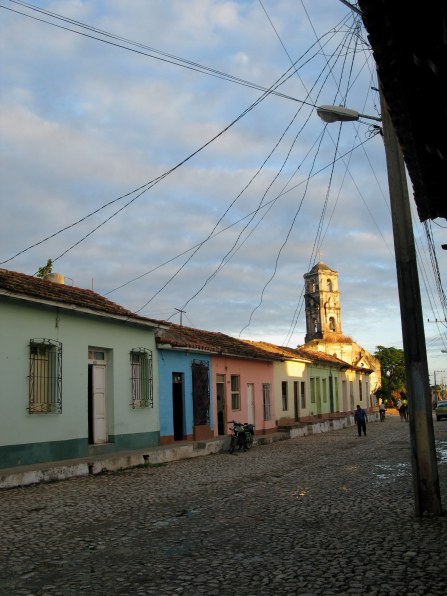
The centre of Trinidad is all that most tourists see.
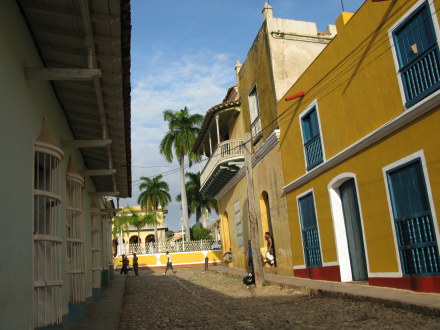
It is what the English would say is 'small but perfectly formed', with its Spanish colonial square – the Plaza Mejor.
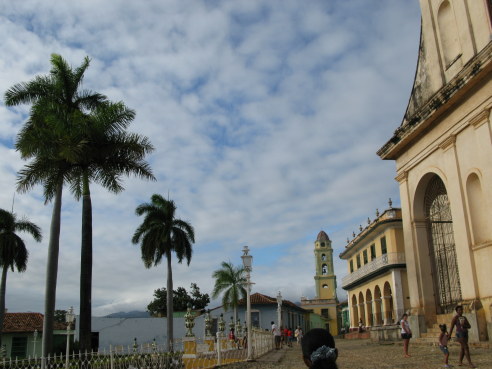
The Plaza Mejor sits at the top of the town.
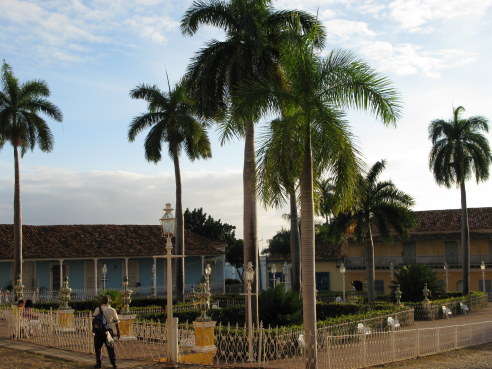
It is a peacful and charming sqaure, where even the fencing is a thing of beauty.
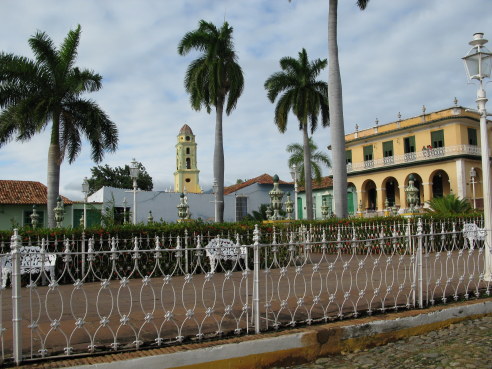
Off the Plaza Mejor every doorway seems to frame something of beauty or interest.
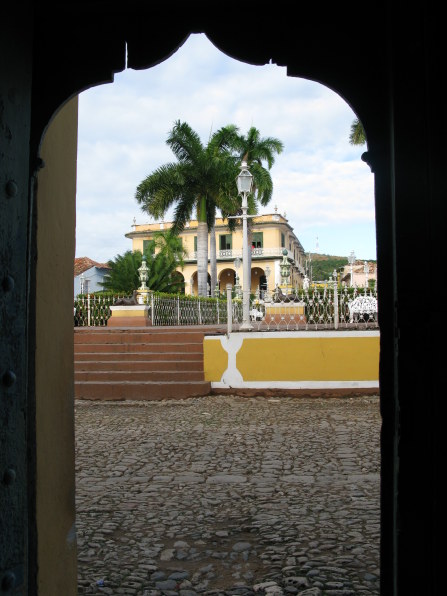
Bar, restaurant, curiosity shop, and home:
Bar Restaurante Esquerra in Trinidad de Cuba
It’s thirsty work exploring and we had been driving for some time before our arrival, so we stopped at the Bar Restaurante Esquerra for refreshments and to enjoy the music.
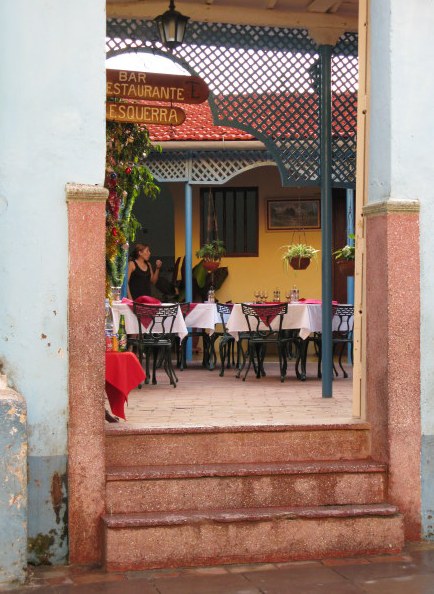
The band was playing heart-tugging songs of love in Cuban Son…that Cuban mix of the Spanish canción and the African use of percussion.
They were a seasoned group and roved seamlessly from one song to the other.
The music begged some dancing - and it would have been rude not to.
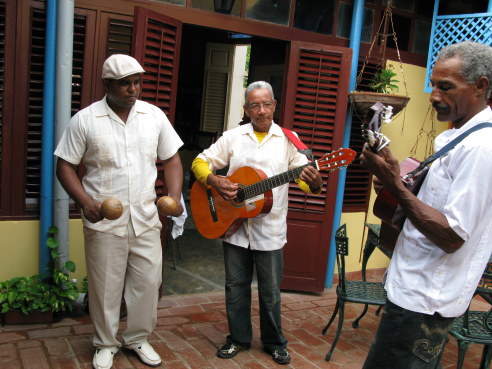
The song themes moved to one celebrating Campay Segunda for his promotion of Cuban music and the lament for El Commandante: Che Guevara.
I had been peering through the doorway and saw there was a shop inside the attached house.
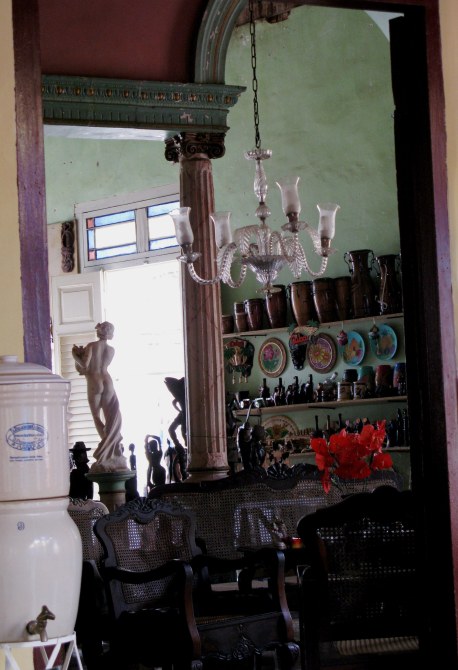
As if to be sure I returned, as I wandered off the music drifted after me on the warm humid air, now telling of a deep but impossible love.
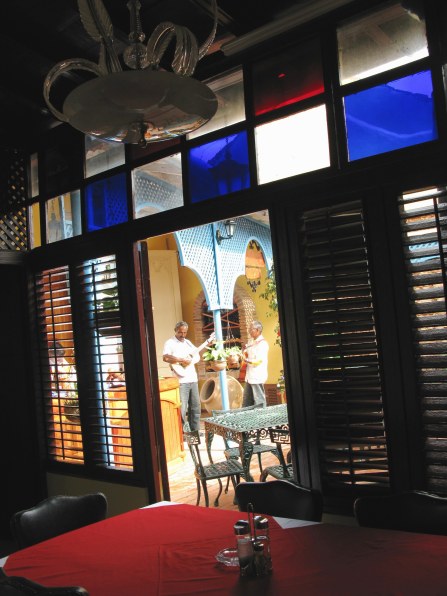
Since the change in government restrictions allowing locally owned businesses, Trinidad de Cuba seems to have some sort of business out of every house in its centre, with the whole family involved, whether as sales assistants or product producers.
This house was at the same time home, restaurant and bar (on the patio), and shop.
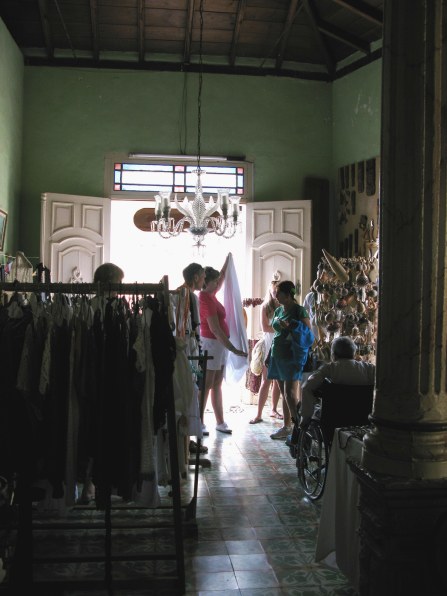
There were beautifully crocheted goods including pulled-thread and embroidered tablecloths.
Some one-time family treasures were also for sale.
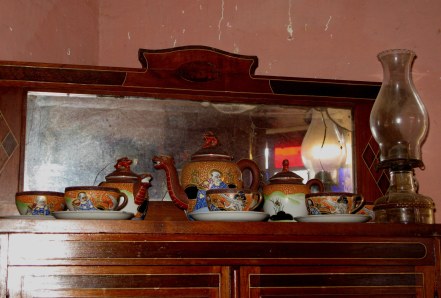
The display cases are the everyday furniture of the household, like this antler-bedecked mirror.
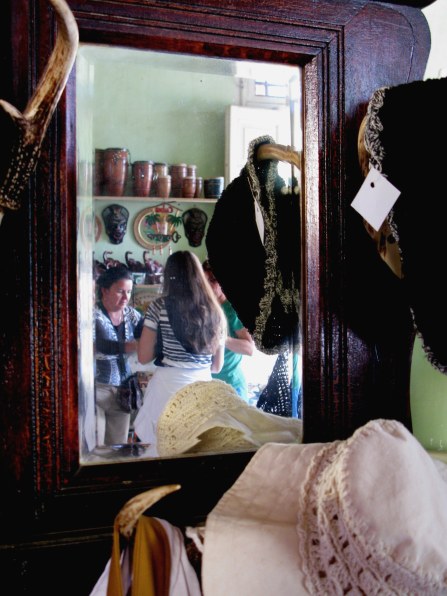
It is a strange experience to be inspecting shop goods in someone’s living room.
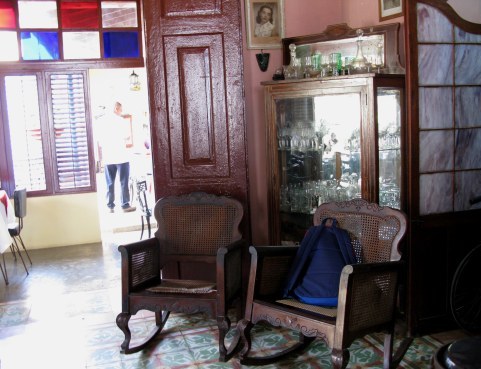
The bar was on the patio behind me.
Off through a doorway was the private bedroom.
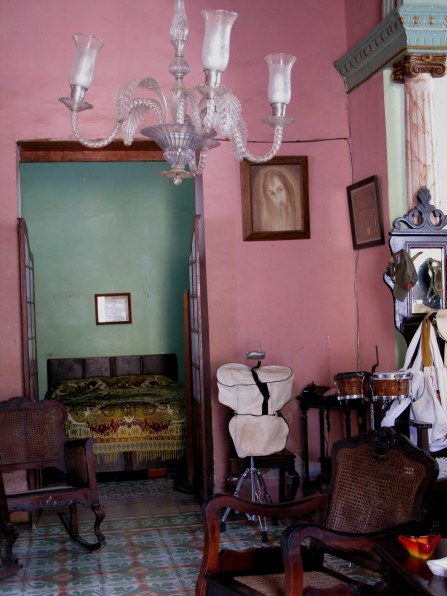
Beside a home, this multi-functional household had also created a shop.
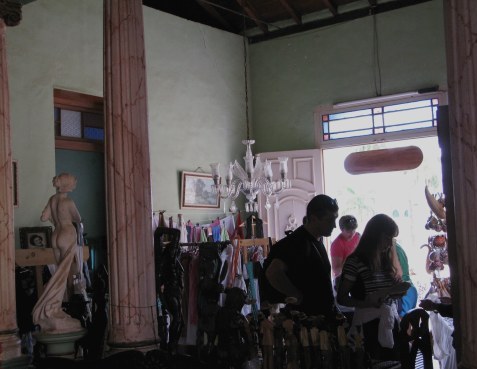
The front door opened right onto the square of the Plaza Mejor.
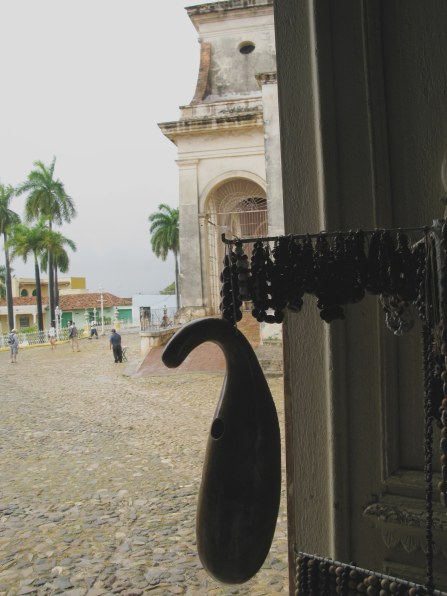
As I turned to go back to my friends and the music, and thoughtfully watched the family at their business, I had to force myself not to say something when I watched a tourist trying to beat down the price on a lovely pulled-thread tablecloth.
This is not a middle Eastern bazaar where bargaining is expected and the price set accordingly. It is Cuba and the price is the price.
OK. You might be able to get a bit of a better price by buying more than one – but why would you?
It is obvious that the people need the money. On my trip with Cuban families I had seen already how relatives would have been crocheting and embroidering and pulling threads and carving and crafting like mad to help gain some valuable CUC currency to supplement their meagre earnings in Cuban pesos.
But it is a Cuban saying that:
When you return the asses kick most of the pain is yours
I therefore applied 'The Cuban Approach' to my immediate instinct to express my thoughts, and instead of doing so returned to be captivated by the music.
The Cuban son music called me back with its plaintive story of the separation of two lovers and how they still lived in each other’s heart.
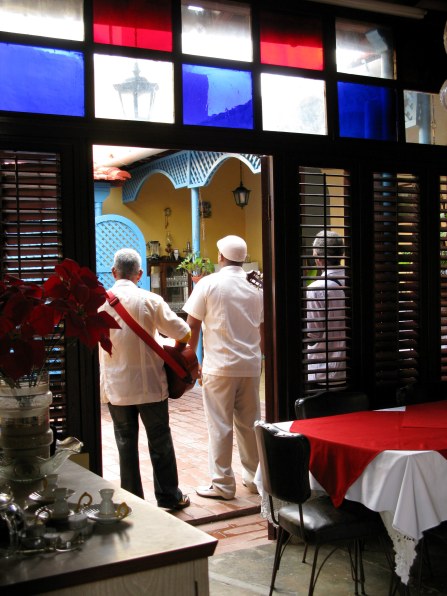
Wandering the streets of Trinidad is like viewing several living cameos
We finally set off on our explorations once more.
Song birds in their cages had been set outside an antique shop to enjoy the sunshine.
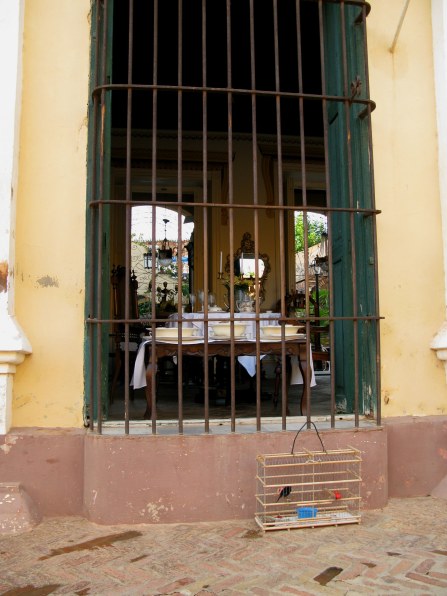
One cage sat outside each street window.
I wondered at the fascination with caged song birds that I saw throughout Cuba.
It seemed a sort of tragic metaphor for the difficulties Cubans have in departing their country – even on a visit.
Then, I remembered the quote frequently wrongly attributed to Maya Angelou but orginally that of the poet Joan Walsh Anglund, who said:
A bird doesn't sing because it has an answer,
it sings because it has a song
Perhaps my metaphor had more meaning than I first thought, for I met lots of Cubans busy 'singing their song'.
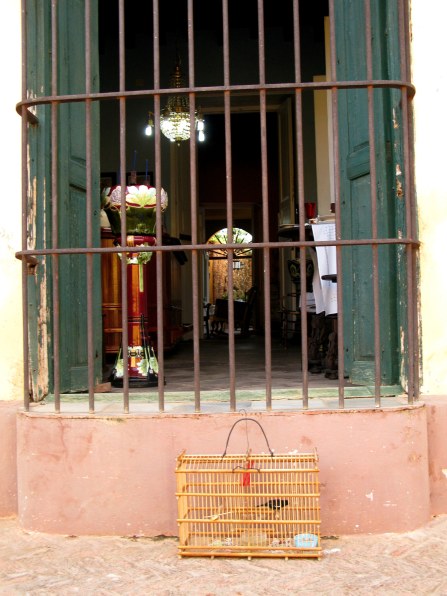
I peered through the window grill at the antique display …
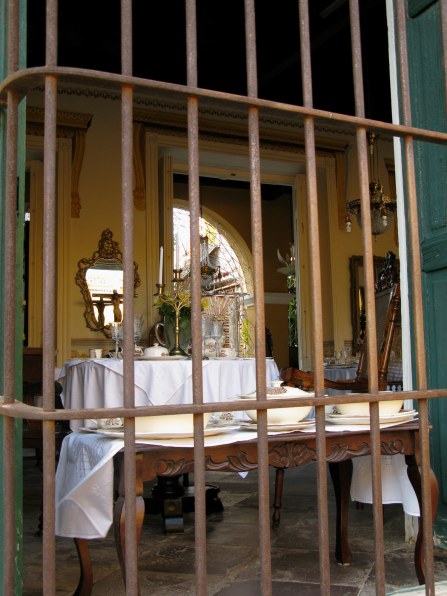
….and was naturally drawn inside.
Perhaps the birds were tiny musical buskers.
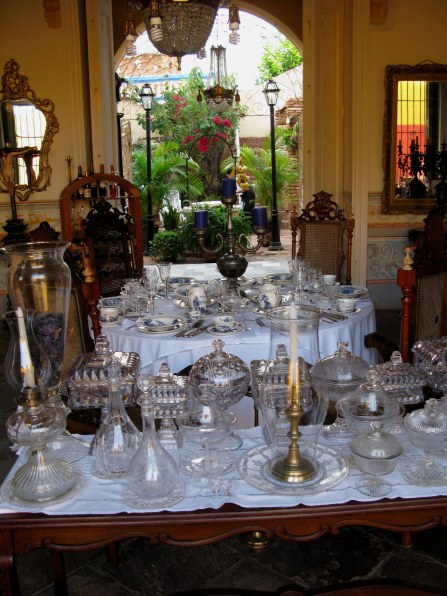
Here, were the family treasures of an era when they held some value in a type of every-day life long since passed in Cuba.
Of necessity, now the focus is on things of a more practical nature.
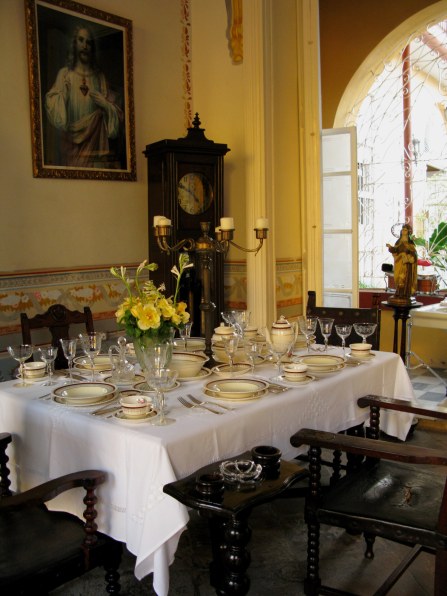
By the way everything was beautifully arranged, it is obvious that the sense of culture and style has remained...
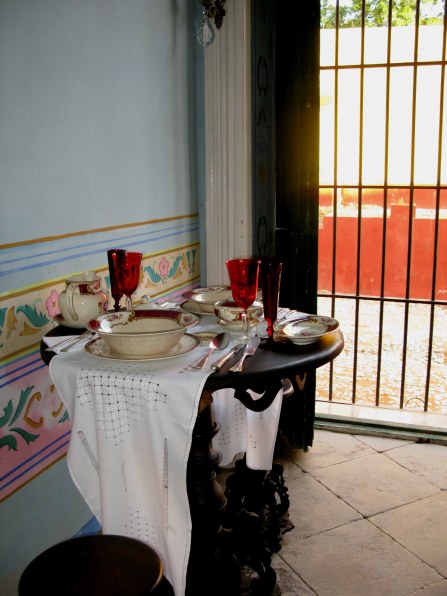
…despite the necessity of family economics meaning that these treasures have to leave the home in return for something more practical – like a set of drums.
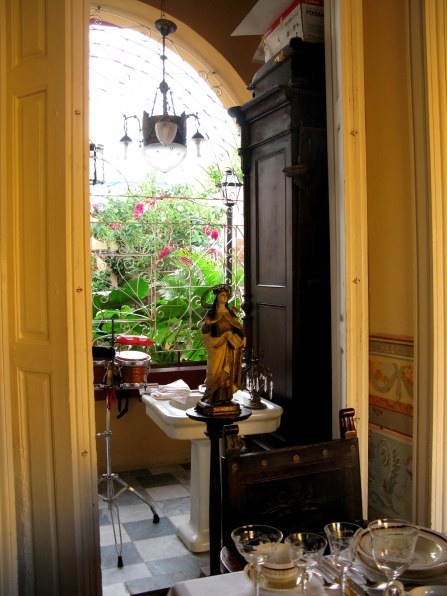
The gardeners and craftspeople of Trinidad de Cuba offer their wares
Other goods on sale in the streets of Trinidad de Cuba were the inevitable home-grown vegetables…
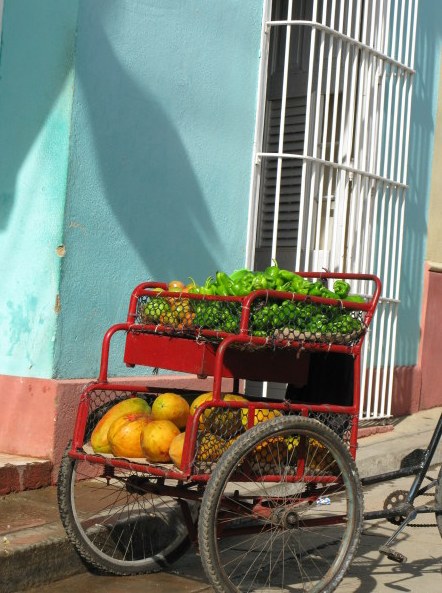
..and curiosities like these little cameras made out of empty cans of Crystal and Buccanero beer, and Orange drink.
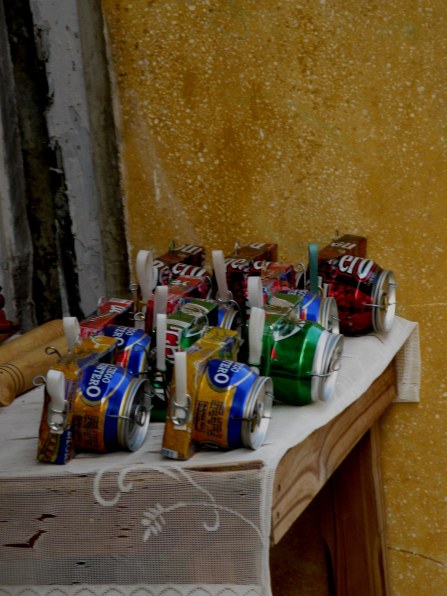
The shops varied in size – this one long and narrow and watched over by a sleepy dog behind the window grill.
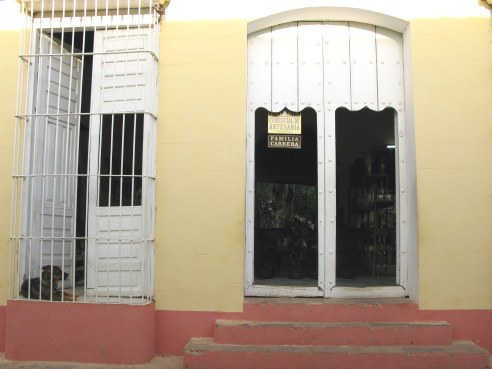
Hostal La Negra in Trinidad - a welcoming apartment with great catering
I was staying at a family-run apartment that would take some beating.
Hostal 'La Negra' is air conditioned, has parking, and is comfortably appointed.
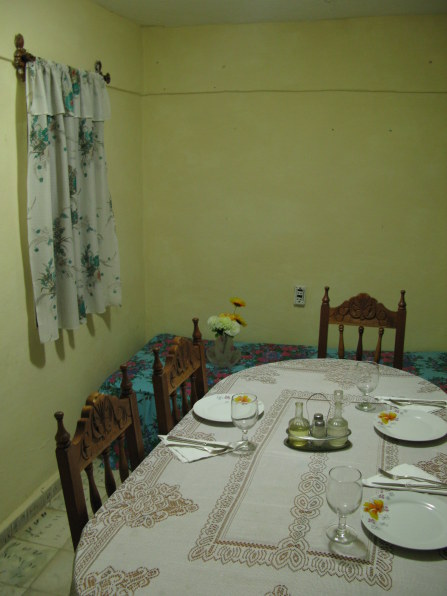
There are two bedrooms and a proper bathroom and shower, with a private terrace on which to dine.
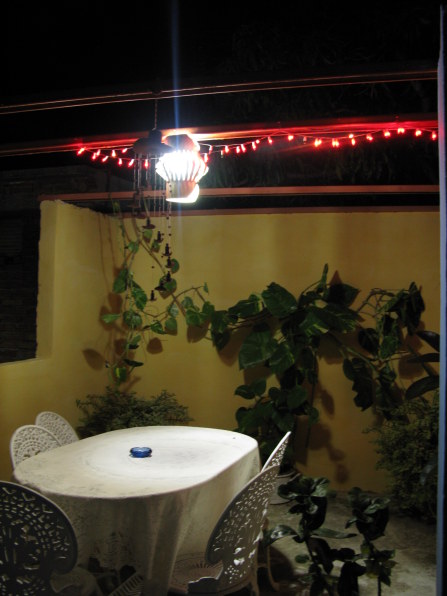
All this is under the care of good humoured hosts who offer delicious home-prepared food.
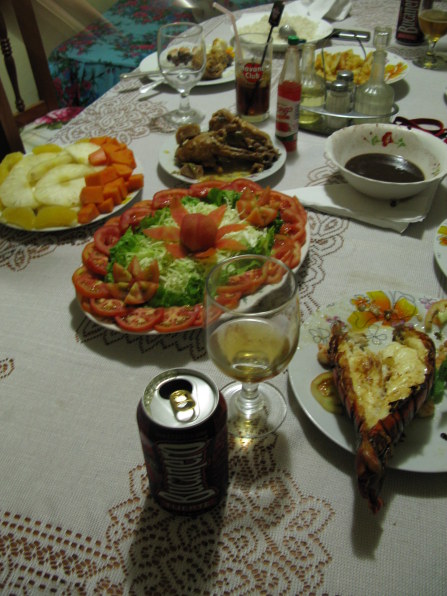
Hostal La Negra is located just above the ruins of Iglesia Santa Ana in the heart of Trinidad.
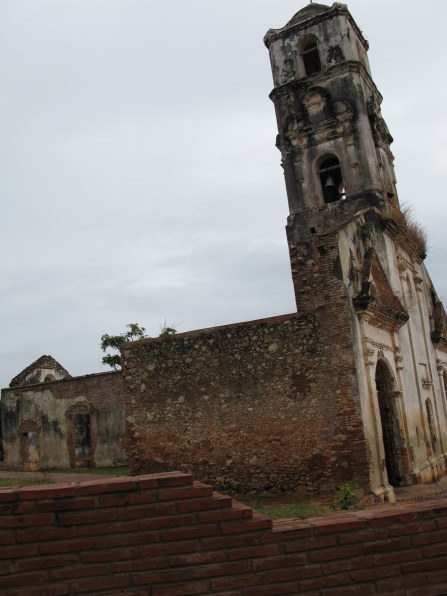
The church of Saint Ann is a ruin whose façade seems a bit precarious.
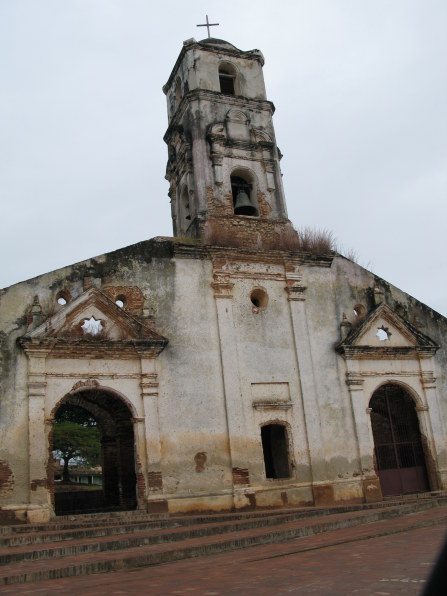
The ruins of the church sit on a site that is a favouritefor young kite flyers, and also for occasional musical concerts.
For me it also made an easy landmark to guide me home after a night of dancing.
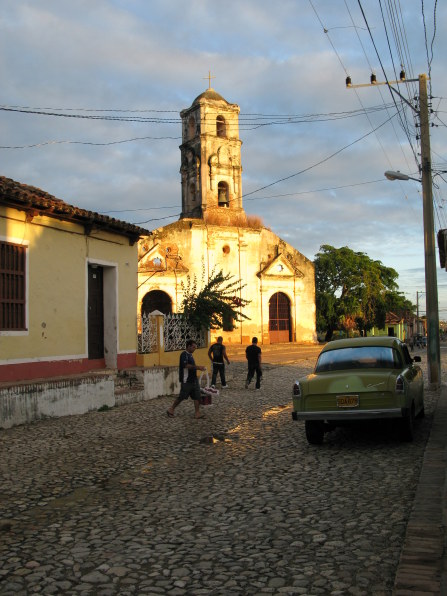
Hostal La Negra is located on Fausto Pelayo Alonso 251, between Lino Perez and Restoy Fajardo.
(The don’t have a website, but if you speak Spanish, call Alejandrina on +53 99 4381 … and tell them Paquita sent you.)
Keeping things spic and span seems a preoccupation in Trinidad, with colour being added when colour can be afforded.
Judging by the reproduction of the colour being added on other houses along the street, and on the house opposite where another man was adding it as well to his house, it seems that paint being the expensive commodity it is, it is shared around when available.
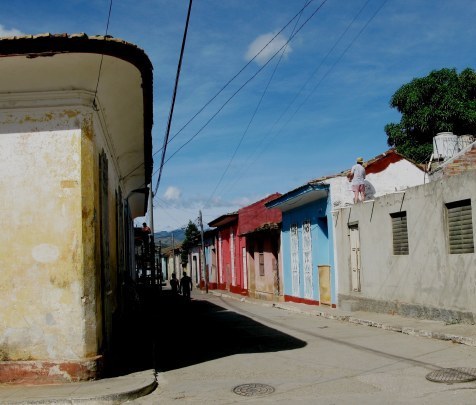
The colourful houses and classic cars of Trinidad de Cuba
As with everywhere in Cuba, transportation in Trinidad varies from the modern tourist rental cars, through to classics like this old Ford Consul.
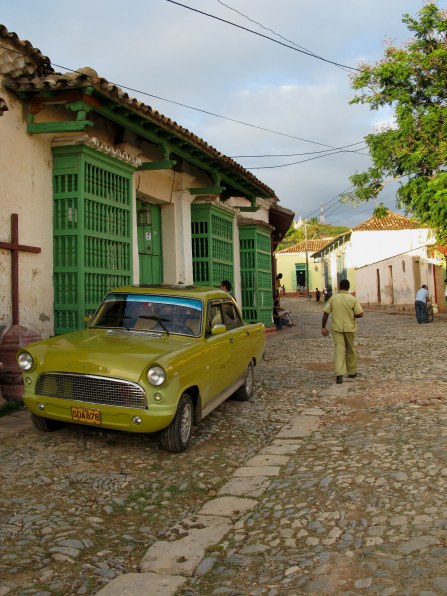
It is something I never get used to in Cuba – seeing the setting to be so in-keeping with the age of the cars.
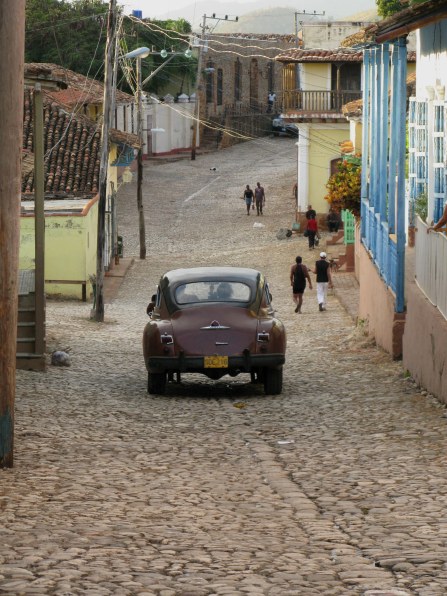
Four-legged transportation in Trinidad de Cuba
In Trinidad there were always the usual mule carts and horse riders.
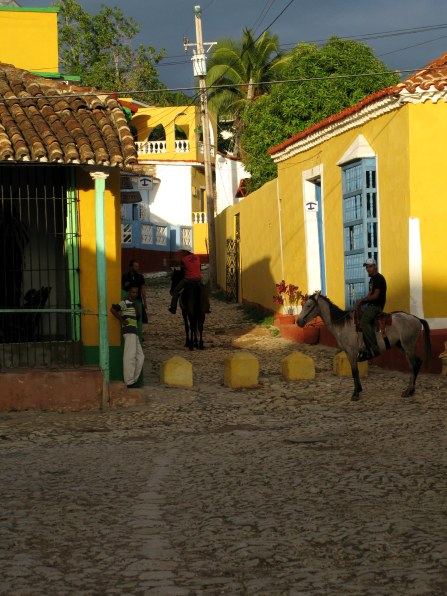
This lad was waiting – not an uncommon activity in Cuba – but on horseback.
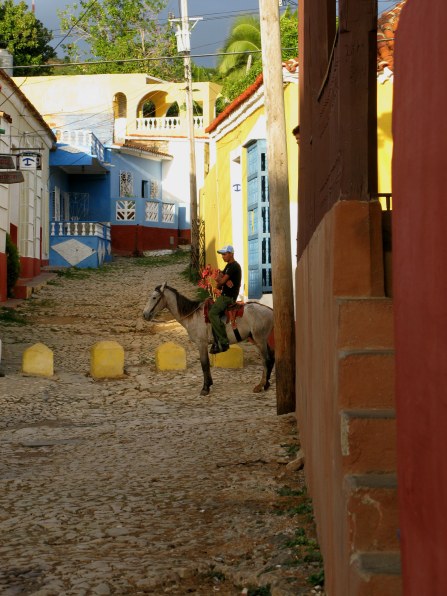
Trinidad de Cuba: not so much 'beauty' as 'personality'
Although I am not sure quite what I expected of Trinidad de Cuba, before my visit I made the mistake of visualising something in response to the many comments about its beauty.
In fact, I found it not so much beautiful – but character-filled.
It has become quite a tourist hot-spot – and the dancing on the steps of Casa Musica beside the church is not one of my favourite experiences – but behind it is the locals’ haunt.
I think I was the only tourist there – wild Cuban Reggaeton at full volume under hanging vines against the cliff face.
Wonderful – the music coursing through your whole body and an atmosphere that is hard to capture in words – perhaps best summed up as 'exuberant'.
Outside of town, the cave bar, with its seemingly impossibly steep track with 50s cars steaming up it under the practiced hands of excellent Cuban drivers – and the surreal experience of climbing deep into a rock cavern that is a wild disco – is certainly a memory to take home.
I think I danced from about 11:30pm to 3:30am almost non-stop.
Not that I liked the place or anything like that!
For me, Trinidad de Cuba is a place that you can interpret as a tourist trap where people are always trying to sell you something (something I have seen written a lot but actually never experienced – just a few calls as I passed and when I smiled and shook my head – that was that), or as a place hovering between centuries and testing the opportunities that legalised commerce brings.
As everywhere, there are images that are orchestrated but colourful, like this guitar player outside the church.
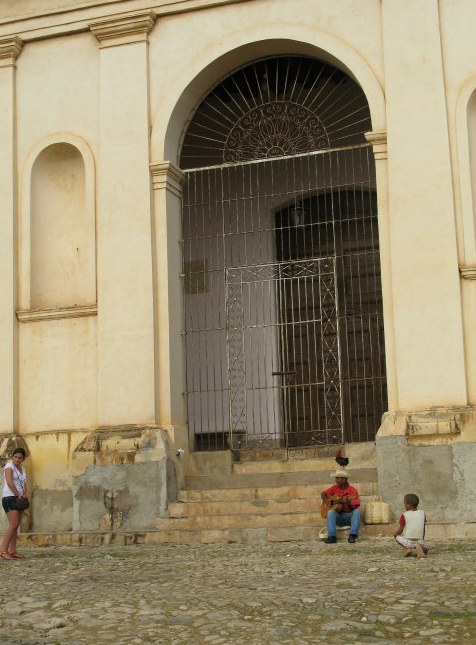
The guitarist had a pet rooster on his straw hat, something no doubt planned – but the absolute wonder and fascination of the young local lad crouched before the guitarist added tot he sound and made the vignette really moving.
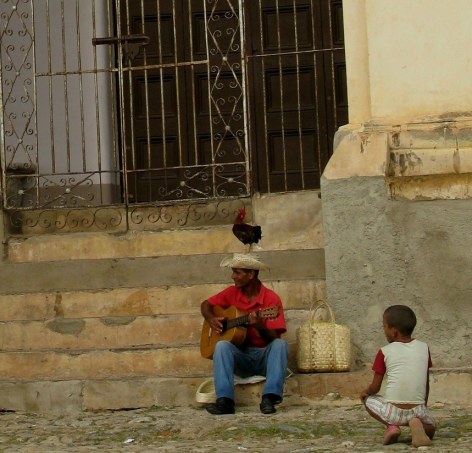
What to do with nothing to do and all day to do it
There are the images of everyday reality in Trinidad that that make you grateful for the ease of the life available to those of us outside Cuba, with jobs, and the money to do the things we enjoy.
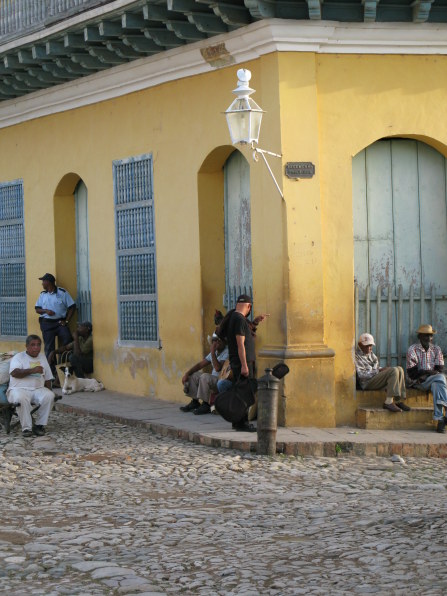
I have heard and read so many conflicting versions of the history of Trinidad de Cuba that I am reminded of the quotation of the historical writer Roy P. Basler, when he said:
To know the truth of history is to realize its ultimate myth
and its inevitable ambiguity
Travel is an unfolding map that consigns whatever sketchy preconceptions of place you had before you got there to that impossible-to-read place I seem to have on every map: the spot on the fold where the original detail is tattered at the edges.
After you have experienced a place, your prior map of it is so sufficiently worn by use that it is impossible to recall clearly your past expectations of it.
Once a new place is well explored, the realities it has revealed and your memories blur all the concepts of it that you had before you arrived, and so it was for me in Trinidad de Cuba.
More Pages on Cuba here:
Havana pages
Agricultural
Fair
The
Art of Dominoes
Havana
Back Street Rambles
Capitol
Building
Havana
Classic Cars
Creative
transport in Havana
Malecón
- Fish and Philosophy
Havana
Angels
Havana
Grandeur
Political
Demonstration
Street
Water Skiing
Trinidad de Cuba pages
Remedios
Remedios
churches
Parrandas
& Pedlars
Other Cuban pages
Cienfuegos
Almendares
River Voodoo
Backroad
Travel
Bay
of Pigs
Viñales
- Pinar del Rio
